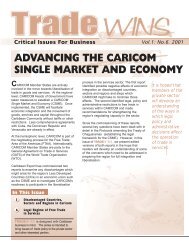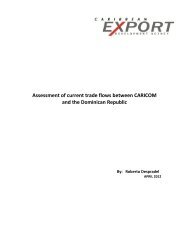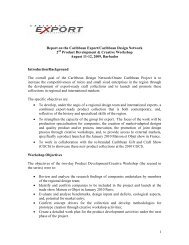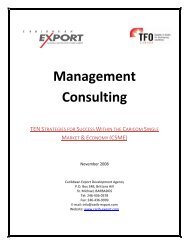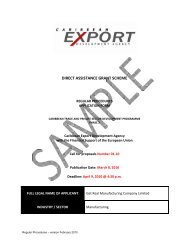Market Access Manual for Artisans Rev2 - Caribbean Export ...
Market Access Manual for Artisans Rev2 - Caribbean Export ...
Market Access Manual for Artisans Rev2 - Caribbean Export ...
You also want an ePaper? Increase the reach of your titles
YUMPU automatically turns print PDFs into web optimized ePapers that Google loves.
Essential requirements <strong>for</strong> packaging<br />
In order to ensure that a shipment of goods satisfy the essential requirements <strong>for</strong> packaging <strong>for</strong><br />
the UK, visit http://www.environment‐agency.gov.uk/netregs/63268.aspx.<br />
US REQUIREMENTS FOR WOOD PACKAGING 6<br />
Under a United States Department of Agriculture (USDA) Animal and Plant Health Inspection<br />
Service (APHIS) regulation, the importation of many types of untreated wood articles, including<br />
wooden packaging materials such as pallets, crates, boxes, and pieces of wood used to support<br />
or brace cargo are restricted. The regulations currently refer to these types of wood packaging<br />
materials as solid wood packing materials, defined as ‘‘wood packing material other than loose<br />
wood packing material, used or <strong>for</strong> use with cargo to prevent damage, including, but not limited<br />
to, dunnage, crating, pallets, packing blocks, drums, cases, and skids.’’ Any WPM not meeting<br />
the treatment specifications of this rule will be immediately reported.<br />
Additional in<strong>for</strong>mation on this subject can be found on the USDA Website: www.aphis.usda.gov<br />
Generally, it is recommended that the requirements regarding packaging and labelling should<br />
always be agreed upon and specified in the contract between the exporter and the UK or US<br />
importer in order to meet expectations and to comply with EU and US regulations. The<br />
responsibility <strong>for</strong> compliance with UK and US labelling and marking regulations rests with the<br />
importer and consequently, the UK and US importer usually in<strong>for</strong>ms the <strong>for</strong>eign supplier of his<br />
requirements to packaging and labelling.<br />
Note: Shipping products to <strong>for</strong>eign destinations can be costly, time consuming, and risky. It is<br />
important to familiarize yourself with all of the procedures involved, but even more important to<br />
hire competent experts to properly advise and assist you in this process. This starts with correctly<br />
packaging your products to withstand the multitude of handlers, carriers and inspectors who<br />
may be physically moving or even opening your packages.<br />
More in<strong>for</strong>mation can be found at:<br />
www.agoatoolkit.com/agoa/toolkit_english/II.%20EXPORT%20GUIDES/<strong>Export</strong>ing%20to<br />
%20the%20United%20States.pdf<br />
Points to consider when getting your goods to the final customer:<br />
� A pick up at your warehouse by a domestic freight company’s truck.<br />
� A delivery to a freight consolidation warehouse.<br />
� A shipment from that warehouse to an ocean vessel consolidator or air transport<br />
company.<br />
� Transfer to an ocean container or airplane.<br />
� A waiting period prior to shipment on an airplane or ocean vessel.<br />
� A long trip on a ship.<br />
� Removal of a container at a port of entry.<br />
6 Tradewatch • The Official E‐Newsletter of the <strong>Caribbean</strong> <strong>Export</strong> Development Agency • Vol. 3 No. 6 June, 2010,<br />
Doing Business with USA<br />
26<br />
Page 26






